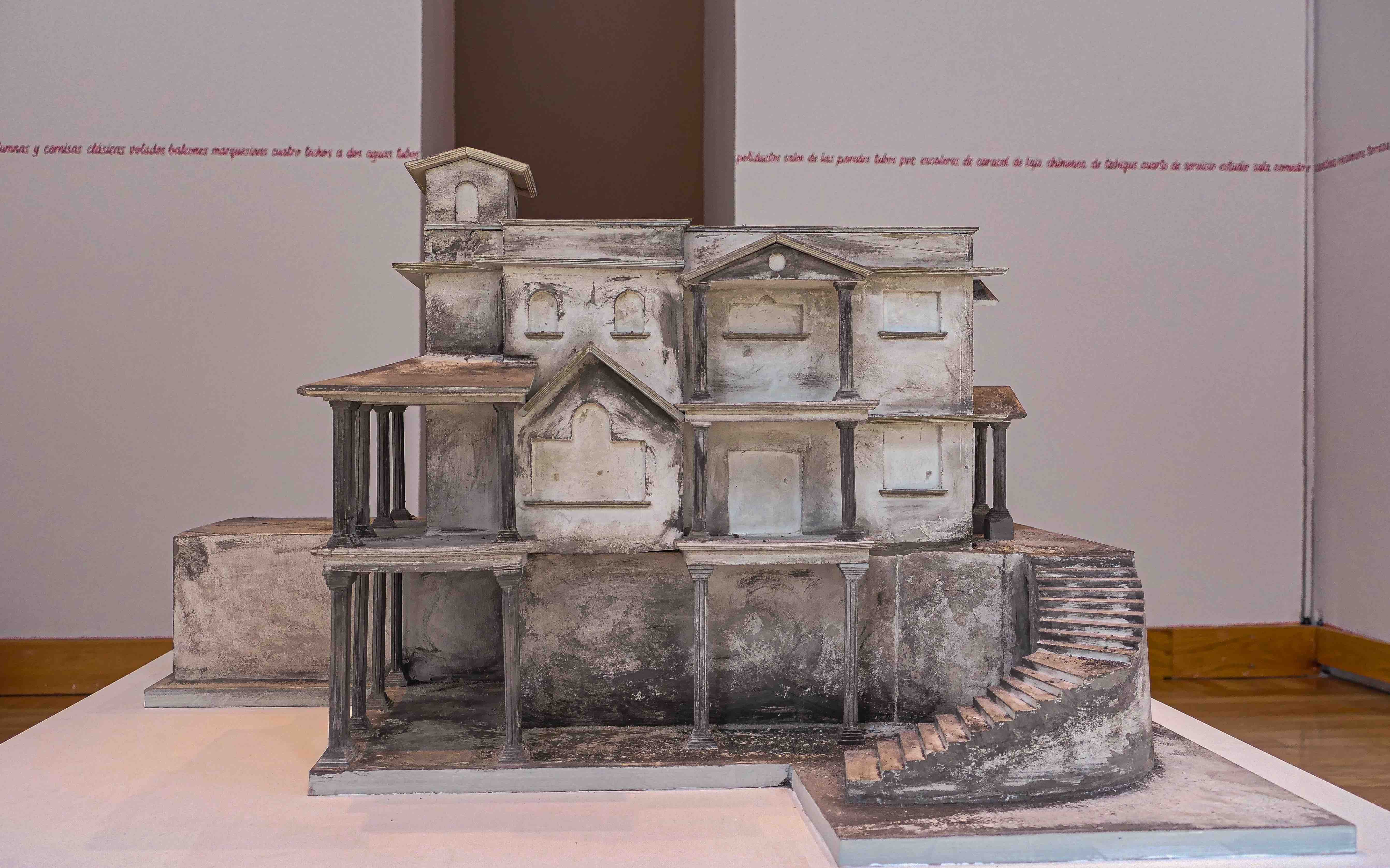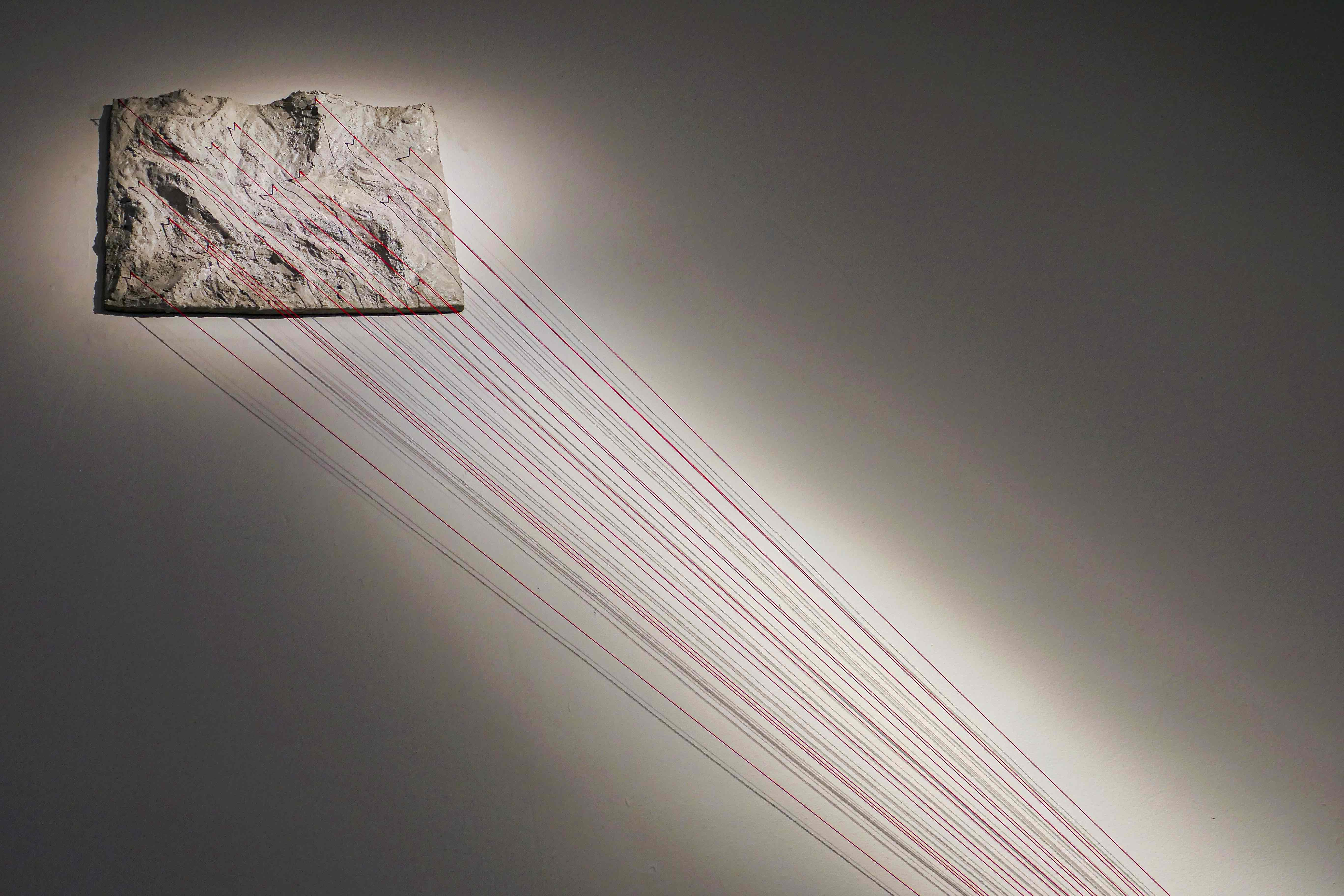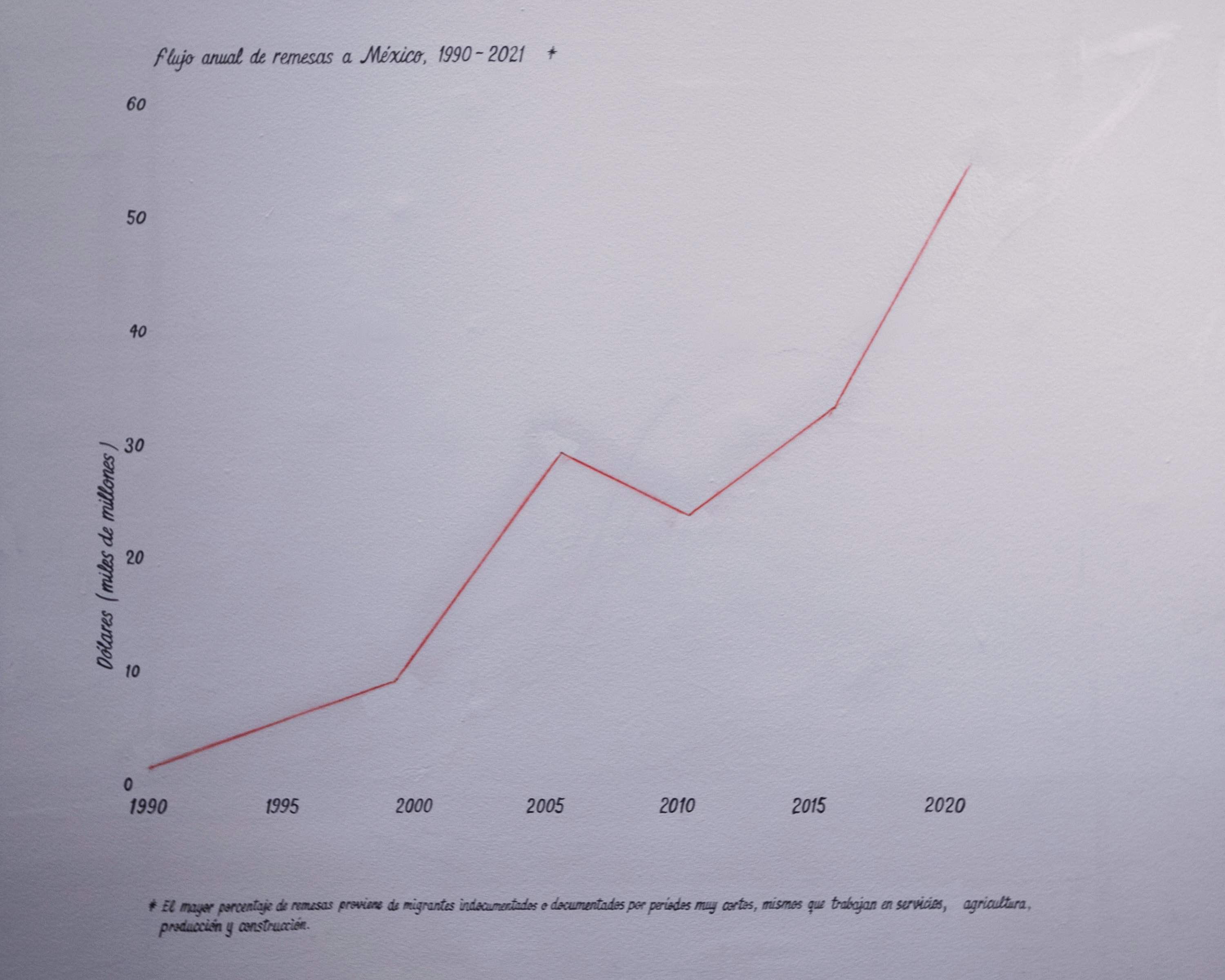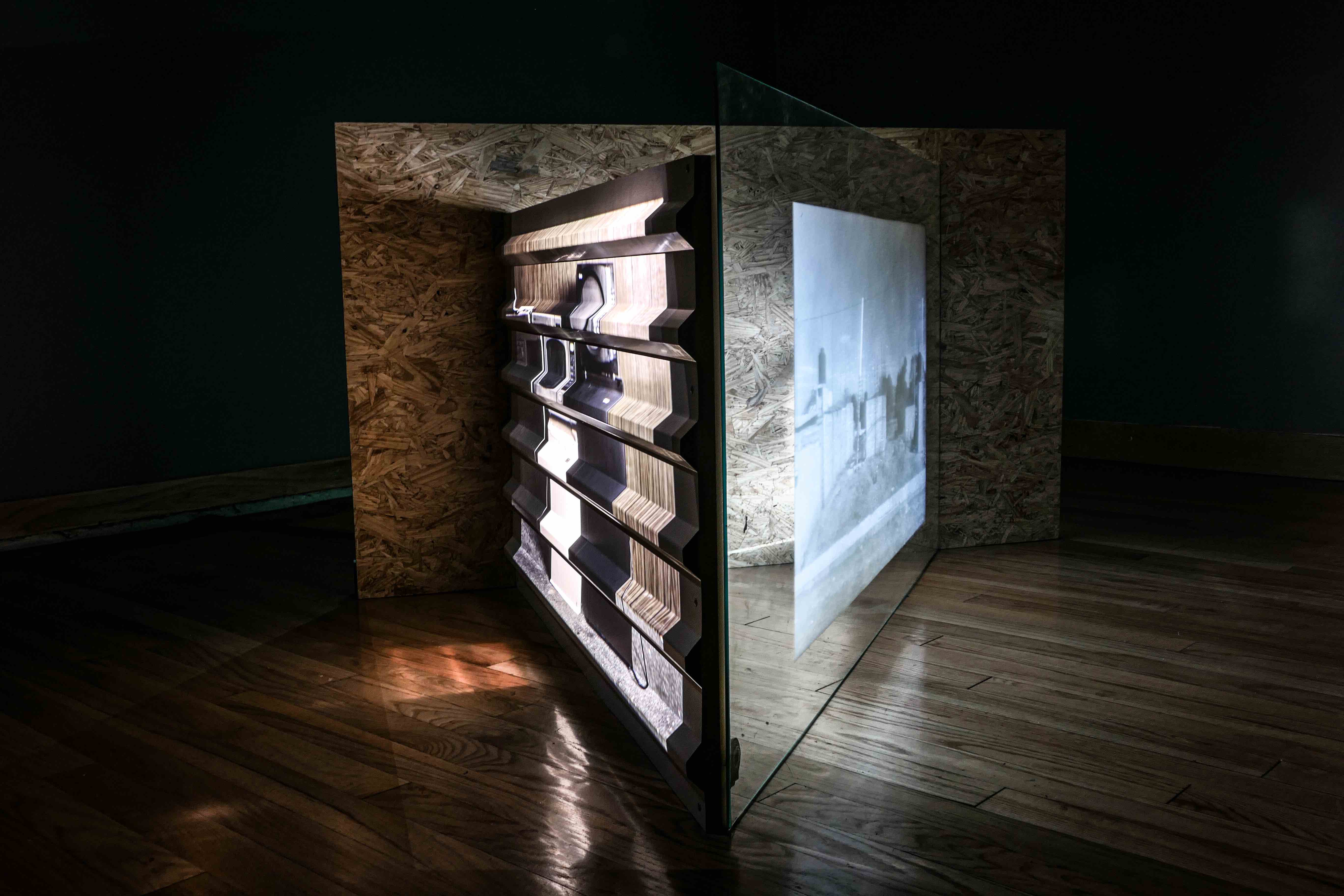
Essay
Sandra Calvo: Between "Copies of Abandonment," red lines and double absence
by Guillermo Boehler
Reading time
9 min
Migrants cannot become citizens, neither in the present nor in the future – this is Abdelmalek Sayad speaking. Sandra Calvo's project resonates with Sayad's concept of the "double absence," coined by the Algerian sociologist to explain the relationship of migrants with their home country and the country that they arrive in: between the one who abandons and the one who invades a nation, between the one who has no rights due to being far from their homeland and the one who lack rights because they’re not in their homeland. Copias del Abandono [Copies of Abandonment], the name of the exhibition, and "double absence" appear to be sibling concepts, two paths of inquiry leading to a complex idea about migration.
Isn't this the relationship that Central American, South American, and Mexican migrants have with the United States? They seek to become self-made individuals, the kind who make it on their own in the United States, seeking the "American dream," pursuing aspirations, trying to fulfill their needs, leaving everything behind to send something back, working extra, doing double, and triple shifts, living in precarious conditions, doing the jobs nobody wants to do, and those jobs are worth twice as much if done by a citizen. However, it's still not enough.
As we gaze at gray models in the halls of the Centro Cultural de España in Mexico, we hear voices recounting a story, one that repeats thousands of times in all media: twenty or thirty years of residence in a country doesn't matter, immigration authorities can still take them away.
***
"I say this with all seriousness: even here, in Mexico, the photo I hate the most and that makes me feel the safest is that of my visa."
***
The condition of a migrant is always temporary, not just in terms of visa expiration. It is, and we continue to think the same as Abdelmalek Sayad, a thought towards the future, always the promise of a return. Consider the contradiction, returning for the future, constructing in the present a ghost that is placed in the future. Coordinating from a distance a home for making a life, a reason to survive. Living in the promise.
***

Tension: You enter the exhibition and see a map: three spaces, two islands, Tlaxcala and Wyoming. The third space is the tension between these two points, the "double absence". That tension, bodies that are neither here nor there, red lines that keep the continent connected, a migratory route that doesn't follow a straight line. That's the problem, there's no easy path, no straightforward route, no codes. But deep foundations are built, promises between making a life and returning, between demographic data and construction materials, between testimonies and migratory forms, between models and The House of Dreams, both frozen in time, between The Model House and nostalgia, between The Inhabited House and two countries.
***
Paranoia, building a house that is a fortress, large and imposing, that is nostalgia, that is a place of observation, building a house with all the aspirational deliriums that keep us alive. It doesn't matter what form it takes, as long as we all fit. The nostalgia it brings doesn't matter – the format of the doors, the Roman columns, the space for the window frame decoration – as long as we are safe. It doesn't matter that not all services reach the lands we could buy; it's our landscape, we put it together, we make it livable. The hardest part is already done, we crossed the border with nothing, now it's our kingdom, our land upon return.
***

The house in Tlaxcala and the American house both built by the same hands. The first designed to accommodate everyone, the second to be empty, an exhibition model, between presence and absence, between all jobs and the dream job. There is no romanticism, just sheer will.
Now, the issue of labor: "produce more with minimal expenses," says the real estate developer, but if the same hands use their skills to build their own homes, if they start to claim the landscape, if they dream of their family's tranquility, if there are bodies that make space, that create space, they become inconvenient to the state.
We hear in the recording of an interview one of the migrants says something like, "woodwork in the United States is very different from woodwork in Mexico." Specialization, spatiality, a house for the mountain cold is not the same as a house for the heat of Tlaxcala. An empty house in Wyoming is not the same as an empty house in Tlaxcala. A ghost in Tlaxcala is not the same as a ghost in Jackson Hole. The future, that is, the topical horizon where these people live, has another tension, they live on the red line connecting topographical maps.
***
A group of graphs and infographics conclude the journey, demographic and economic data. In grays and reds, information about billions of dollars in remittances: red line. Millions of documented and undocumented migrants: red line. More than nineteen thousand in Wyoming: red letter. In this state, 23% of migrants are from Tlaxcala: red letters.

And what about the gray? What is not emphasized but inherent to this situation? Graphs that could indicate the demographic flow between the two countries show us something more. The gray, like the cement of unfinished houses in Tlaxcala, reveals states that rely on an economic dynamic between the Mexican state and the American state, remittances for one, labor for the other.
Citizens defend their market, repeating the discourse about their own identity preserved in everyday words, in legal jargon, from freedom of expression to defending the nation, but their home, their homeland (both American and Mexican), is built and funded by migrants. Their markets have one of their legs held up by cheap labor, with no labor or tax rights. The same law that condemns the migrant is the one that guarantees land and asylum, a dignified life, a minimum wage, education, and competition among nationals. However, a citizen will deny that their sovereignty is sustained, among many other things, over the migrant.
The exhibition is not about the precariousness of housing, it does not victimize migrants, nor does it point to immigration as the problem. Sandra Calvo and all of her collaborators show, among many other things, the inhuman game between two states, where the pieces are all those who seek to build a place for life.
***

Let us not focus solely on what the project shows us. Alongside what Calvo reveals, we must discuss what is not present, which makes the represented reality possible: the citizen maintains (whether they are aware of it or not) their sovereignty over all those non-normalized bodies that enable the construction of a homogeneous identity, whether through their subordination or through destruction. The conditions experienced by migrants are not inherent to the legality or illegality of their passage, but are reproduced by citizens and institutions that make this relationship with bodies they consider strangers possible.
We know that it makes no difference whether it's a Democratic or Republican government; immigration laws do not soften; they have only become more complex over the last thirty years. On the other hand, in the eyes of Americans, migrant labor is always worth less than citizen labor, which is why they continue to pay for their work, and migrants continue to cross. Visit the CCEMx until October 8th, listen to the testimonies, see the three houses, read the graphics, and consider everything that sustains the immigration system.
Translated to English by Sebastián Antón-Ojeda
*1: “<<Exportan-se>> ou <<Importan-se>> exclusivamente trabalhadores, mas nunca… cidadãos, atuais ou futuros”. Original text in Portuguese. [<<Export>> or <<Import>> exclusively workers, but never... citizens, current or future]. (Sayad, A. (1998), A imigração: ou os paradoxos da alteridade. Editora da Universidade de São Paulo. p. 66)
*2: “Contradição apontada por Sayad enquanto “dupla ausência”, decorrente das dificuldades do imigrante em atuar social e politicamente tanto no país de origem como no país de destino; fisicamente afastado num e social e politicamente alijado no outro. Cesura inicialmente provisória ou justificada como tal que, logo, se descobre duradura ou definitiva e acaba subvertendo os modos de produção de subjetividade do migrante e solapando seus desenhos sociais e existenciais.” Original text in Portuguese. [A contradiction pointed out by Sayad as a "double absence", resulting from the immigrant's difficulties in acting socially and politically in both the country of origin and the country of destination; physically distanced in one and socially and politically alienated in the other. This is initially a temporary or justified curse, which soon turns out to be lasting or definitive and ends up subverting the migrant's ways of producing subjectivity and undermining their social and existential designs.] (Elhajji, M. y Escudero, C. (2020) Sentidos e expressões da noção de ghorba na obra de Abdelmalek Sayad, p. 170, en Alves Pereira, J.C., Batista, D. , Bógus, L. y Dias, G. (organizadores) (2020), A contemporaneidade do pensamento de Abdelmalek Sayad, EDUC PUC-SP, p. 157-177.)
*3: En esta colección de textos A contemporaneidade do pensamento de Abdelmalek Sayad (Alves Pereira, J.C., Batista, D. , Bógus, L. y Dias, G. organizadores, 2020), se encuentran muchas definiciones de esta noción trabajada por Sayad, acá escogemos esta y la siguiente para sintetizar esta idea: “Assim, se configura a dupla ausência: ausência na/da terra da gente (partida). Uma sorte de ausência presente; e ausência na terra que não é da gente (chegada não reconhecida). É uma sorte de presença ausente.” Originial texto in Portuguese. [Thus, the double absence is configured: absence in/of our land (departure). A kind of present absence; and absence in the land that doesn't belong to us (unrecognized arrival). It's a kind of absent presence.] (Moraes Silva M.A. (2020), O Que O Imigrante Traz Em Sua Bagagem? O Que Ele Deixa Para Tras?, p. 229, en Alves Pereira, J.C., Batista, D. , Bógus, L. y Dias, G. (organizadores) (2020), A contemporaneidade do pensamento de Abdelmalek Sayad, EDUC PUC-SP, p. 225-246.)
Published on September 17 2023